Scotland Housing Awards 2025
Read all the shortlisted entries into this award category, excellence in regeneration and sustainability, at the Scotland Housing Awards (SHA) 2025 and find out who won the award on the night.
This award acknowledges the critical importance of a range of bodies, organisations and local groups in revitalising communities and neighbourhoods. It also recognises that physical improvements go hand-in-hand with social and economic developments to make a real difference to people’s lives.
This award was sponsored by Kingdom Group.
Winning project name
Calton Village
Winning organisation
Wheatley Group
Partner organisation
McTaggart Construction
Statement of support
Wheatley Group and McTaggart Construction’s Calton Village represents an example of regenerative development, demonstrating how strategic housing intervention can catalyse full urban renewal. This affordable development of 123 homes transformed a contaminated brownfield site into a thriving community, demonstrating regeneration's potential to strengthen urban fabric while addressing Glasgow's housing needs.
Wheatley Group is Scotland’s leading housing, care and property-management group, managing or owning around 96,000 homes and delivering services to over 210,000 people across 19 local authorities in Scotland.
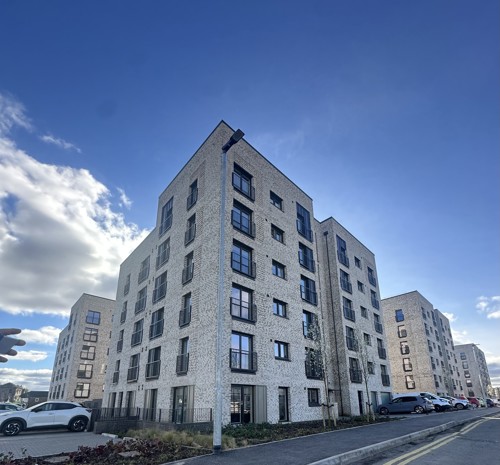
Wheatley was recently named as the UK’s largest builder of social rented homes in the UK. Wheatley delivered more social rent homes than any other housing provider in 2024-25, building 563 homes for social rent in the last year.
Located within Glasgow's regeneration corridor, Calton Village aligns with the council's Calton area development framework and Calton-Barras action plan. The development’s position connecting Glasgow's city centre with the east end makes Calton Village a catalyst for broader regeneration along the Gallowgate corridor, demonstrating how housing development can accelerate wider urban renewal.
Calton Village's design prioritises regeneration through intelligent placemaking. The evolution from perimeter block to six-storey square block maximises daylight while creating streetscapes that strengthen neighbourhood character. The incorporation of pre-existing diagonal desire lines into pedestrian and cycle paths enhances connectivity.
The development's architectural response creates consistency with surrounding areas while establishing distinctive identity. Roof terrace communal gardens provide outdoor spaces with views across Glasgow Green and the city centre, reinforcing residents' connection to Glasgow's broader urban landscape and strengthening the integration between disconnected neighbourhoods.

Calton Village created over £7.5 million in social and economic return, directly investing in the community. A jobs and training programme for long-term unemployed residents created 28 employment opportunities, addressing regeneration's requirement to provide economic pathways.
Local supply chain prioritisation and surplus material donation to community projects demonstrate circular economy principles while ensuring regeneration benefits flow to local businesses. This approach strengthens the area's economic ecosystem, creating multiplier effects that extend the project's regenerative impact beyond its physical boundaries.
Over 500 hours of educational engagement with local schools and community groups built local capacity while incorporating resident feedback into design. This collaborative approach ensures regeneration serves community needs rather than displacing established networks.
The 20-minute neighbourhood concept reduces car dependency while promoting local economic activity, ensuring residents can access essential amenities within walking distance. This planning principle supports regeneration by strengthening local retail and service provision.
The project achieved 15 per cent carbon emissions reduction through district heating networks, enhanced fabric performance, and integrated PV panels. Rain gardens manage stormwater while enhancing biodiversity and filtering pollutants, demonstrating how housing development can improve environmental conditions rather than merely avoiding harm.
The District Heat Network uses a centralised combined heat and power system fuelled by gas to generate heat and electricity, eliminating individual boilers. Each home has a heat interface unit controlling heating and water distribution.
The system operates at twice the efficiency of standard heating (45 per cent efficient boilers), maintaining constant heat circulation with only 30 per cent heat loss during recovery. This localised network achieves 15-40 per cent lower carbon emissions per home through energy efficiency and sustainable building specifications.
Average annual bills are £276 per home for heating and hot water, supporting cost-effective living. The system has achieved Glasgow gold standard, sustainable gold and silver standards, and silver compliance for water heating. Calton Village proves that exceptional regeneration emerges from comprehensive partnership between client, contractor, and community.
Through innovative design, sustainable technologies, engagement, and uncompromising quality standards, this development creates a regeneration model that strengthens communities while addressing housing needs, showcasing housing's transformative potential in driving positive urban renewal.
Outcomes and achievements
Calton Village exemplifies regeneration excellence through comprehensive brownfield transformation, converting a contaminated industrial site into a thriving community that anchors Glasgow's strategic regeneration corridor. The development's strategic positioning connects the city centre with the east end, complementing adjacent Meat Market district redevelopment and catalysing broader Gallowgate corridor renewal.
The project generated exceptional regeneration impact, delivering over £7.5 million in social and economic return while creating 28 new employment opportunities through targeted training programmes for long-term unemployed residents. Over 500 hours of educational engagement with local schools built community capacity, while comprehensive stakeholder collaboration ensured resident-led design development.
Environmental regeneration was achieved through 15 per cent carbon emissions reduction via district heating networks and integrated renewable technologies. Innovative rain gardens provide sustainable stormwater management while enhancing biodiversity. The circular economy approach prioritised local supply chains and donated surplus materials to community projects.
Design innovation maximised regeneration potential through six-storey square block arrangement that optimised daylight penetration and created coherent neighbourhood character. Unique roof terrace gardens offer panoramic city views, while incorporated desire lines acknowledge existing community movement patterns.
Six wheelchair-standard homes meeting Glasgow's housing strategy demonstrate inclusive regeneration that serves diverse community needs while strengthening vital urban connections.
Shortlisted entries
Govan Housing Group - Water Row Phase 1
Application entry
- Project name: Water Row Phase 1
- Lead organisation: Govan Housing Group
- Partner organisations: Glasgow City Council, Govan Central Action Plan
Statement of support
Water Row Phase 1 in Govan is a landmark regeneration project that exemplifies the power of integrated physical, social and economic renewal. Delivered through a unique partnership between Govan Housing Association, Glasgow City Council and the Central Govan Action Plan, the development has created a high-quality, mixed-use neighbourhood that reconnects Govan with the River Clyde, strengthens the town centre, and reflects the aspirations of the local community.
This £20 million investment has transformed a long-derelict and historically significant site into a vibrant new place to live, work and visit. It has delivered 92 energy-efficient homes for mid-market rent, six community-owned commercial spaces, and new public realm that enhances connectivity and civic pride. Designed by Collective Architecture and developed through an extensive co-design process, Water Row demonstrates a holistic and sustainable approach to urban renewal.
The quality and mix of housing responds directly to the demographic and economic needs of the area. The mid-market rented homes provide an alternative to social housing or private rent for working households on modest incomes. They support mixed communities and help retain and attract residents to Govan. The residential blocks are designed to high environmental standards, incorporating low-carbon heating systems and energy-efficient construction in line with Glasgow’s net zero ambitions.
Water Row is also a story of placemaking. The development has re-established Water Row as a civic gateway to Govan and restored its historic connection with the Clyde. High-quality architecture and landscaping promote a sense of identity and belonging, while the development layout prioritises walkability, active travel, and social interaction. The scheme supports the 20-minute neighbourhood model and reflects the Scottish government’s ambition for resilient, liveable places.
The regeneration benefits extend well beyond the site boundary. The six new commercial units are leased on fair terms to social enterprises and independent businesses, ensuring local economic and social value is retained. Public realm improvements complement wider investments in infrastructure, such as the Govan-Partick bridge, and anchor Govan’s position in the city’s Innovation District. Meanwhile, the energy advice and money advice services delivered by the Water Row Company provide wraparound support to tenants and maximise the social impact of the development.
The project was shaped by an exemplary engagement process. Between December 2017 and June 2018, hundreds of local residents and stakeholders took part in co-design workshops, roadshows, and events. Feedback shaped the masterplan, housing types, amenity provision and public realm design. The process also included direct engagement with the neighbouring show-people community, whose feedback informed inclusive design elements. This approach set a new benchmark for participatory regeneration and ensured Water Row reflects the lived experiences and ambitions of Govan’s people.
Sustainability is embedded throughout the project. From climate-resilient landscaping and SuDS infrastructure to the promotion of sustainable transport and local supply chains, the development has been carefully designed to ensure environmental, social and economic sustainability for the long term.
The transformation of Water Row demonstrates that regeneration can be community-led, design-driven, and future-focussed. It has redefined how strategic sites within deprived communities can be used to create fairness, opportunity and pride. Feedback from tenants, local businesses and civic partners consistently highlights the positive change the project has brought to Govan. As one stakeholder noted during consultation: “This puts Govan back on the map.”
This submission is supported by Govan Housing Association, the Water Row Company and our project partners, who remain committed to delivering future phases of regeneration with the same integrity, ambition and care.
Outcomes and achievements
Water Row Phase 1 was completed in late 2023 and has already achieved significant physical, social and economic outcomes.
It has delivered:
- 92 energy-efficient homes for mid-market rent, helping to meet housing need among working households.
- Six new community-controlled commercial spaces supporting local businesses and social enterprises.
- High-quality public realm that enhances connectivity, safety and place identity.
- Reinforcement of Govan’s strategic role in the Glasgow Innovation District and the Clyde Waterfront regeneration area.
Tenants report high satisfaction with the quality and affordability of their homes. The project has attracted positive media attention and helped reposition Govan as a desirable place to live and invest. It also serves as a replicable model for community-led urban regeneration.
Feedback from tenants include:
- “We have lived in the Govan area all of our lives and never thought we would stay in a property like this. We feel like we live in the Govan Penthouse with the incredible views and balcony”.
- “The new homes are an impeccable standard, moving into water row gives us more financial freedom than private renting did. The water row company and maintenance contractors are fantastic, anything we have needed fixed has been fixed within days, which is a breath of fresh air considering our old private letting company would take months for repairs. From application to handover everything has been seamless”
- “Love my flat high standard and have great neighbours”
Trust Housing Association - Langlands Road, Govan
Application entry
- Project name: Langlands Road, Govan
- Lead organisation: Trust Housing Association
- Partner organisation: CCG Scotland
Statement of support
The Langlands Road development by Trust Housing Association, in partnership with CCG (Scotland) Ltd, represents a landmark regeneration initiative in the heart of Govan. Delivered on a previously underutilised brownfield site, the project has transformed a surface-level car park into a vibrant later-living community, contributing significantly to the physical, social, and economic renewal of the area.
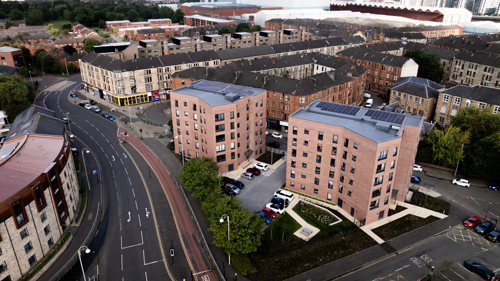
Located at a prominent corner near Govan Cross Shopping Centre, the development enhances the streetscape with two six-storey blocks designed to complement the surrounding tenemental architecture. The use of red brick, feature corbelling, and vertical fenestration pays homage to the local vernacular while introducing modern standards of accessibility and design. The development now serves as a highly visible and positive symbol of Govan’s ongoing transformation.
The development consists of 46 homes which themselves are tailored to support later living, with a mix of one- and two-bedroom apartments, including wheelchair-accessible units. Features such as generous storage, lift access, private balconies in part, and wayfinding elements inspired by Trust’s 50th anniversary branding, enhance accessibility and comfort.
The regeneration impact is multi-layered. Physically, the site has been revitalised with high-quality, affordable homes for over-55s, designed to Housing for Varying Needs and the Glasgow Standard. Socially, the development supports independent living, fosters community cohesion, and has improved safety in the surrounding area through natural surveillance and active frontage. Economically, new residents contribute to local businesses and services, increasing footfall and vibrancy in the town centre.
The project aligns with the Central Govan Action Plan’s vision to make Govan an attractive, vibrant, and prosperous place and its success is a testament to effective stakeholder engagement. Regular consultations with local residents and community groups ensured that the development responded to real needs and aspirations. This inclusive approach has resulted in a development that is not only physically integrated into the neighbourhood but also socially embedded, with strong local support and a shared sense of ownership. The collaboration between Trust and CCG (Scotland) Ltd exemplifies effective partnership working, with both organisations committed to delivering high-quality, sustainable housing. Additionally, Trust Housing Association worked closely with Elderpark Housing Association, one of Govan’s community-based associations, to ensure that both Langlands Road, and another nearby brownfield site in Govan, were developed together in tandem, for the overall benefit of the community.
Langlands Road also contributes to broader regeneration goals through its strategic location. Situated just 200 metres from Govan subway station and bus terminal, and 600 metres from the new Govan-Partick active travel bridge, the development is well-connected to key districts across Glasgow. This connectivity enhances access to employment, culture, and services, reinforcing the area’s long-term viability.
While regeneration is the core achievement, sustainability is embedded throughout. The homes were built using CCG’s closed panel timber system, manufactured locally under zero-waste conditions. This fabric-first approach ensures advanced airtightness and thermal efficiency, with EPC Band B ratings and environmental impact scores of 93. Operational energy costs are as low as £433 per year, helping to reduce fuel poverty and support environmental goals.
The development also promotes sustainable living through limited car parking (30 per cent), generous communal gardens, and a 125 per cent capacity cycle store. These features encourage active travel and create usable “green” pockets of private space for customers within a dense urban environment.
Langlands Road is a model of urban regeneration—revitalising land, enhancing community wellbeing, and delivering lasting improvements in housing, infrastructure, and public realm. It demonstrates how thoughtful design, strategic partnerships, and community engagement can unlock the potential of urban sites and create places where people choose to live, thrive, and grow.
Outcomes and achievements
Langlands Road has delivered 46 high-quality amenity homes for later living, transforming a redundant brownfield site into a thriving residential community in central Govan. The development enhances the local streetscape, improves safety, and contributes to the vibrancy of the town centre.
Designed to Housing for Varying Needs and the Glasgow Standard, the homes support independent living and respond to local housing demand. The project has increased footfall to nearby businesses and public services, contributing to the micro-economy and supporting broader regeneration goals.
Strategically located near major transport links and the new Govan-Partick bridge, the development improves connectivity and access to employment, culture, and services. Community engagement and partnership working with CCG (Scotland) Ltd and the Central Govan Action Plan ensured alignment with local aspirations.
Built using a sustainable closed panel timber system, the homes achieve EPC Band B ratings and environmental impact scores of 93, with energy costs averaging just £433 per year. Features such as communal gardens and cycle storage promote active travel and environmental sustainability.
Langlands Road exemplifies regeneration in action—revitalising land, strengthening community, and delivering lasting improvements with strong prospects for long-term viability.
Respindo Limited - Kirkbrae (69-77), Galashiels
Application entry
- Project name: Kirkbrae (69-77), Galashiels
- Lead organisation: Respindo Limited
- Partner organisation: Scottish Borders Council
Statement of support
The restoration of Kirkbrae is an excellent example of how strategic regeneration can breathe new life into buildings and communities. Empty homes present a wasted resource in our communities and can lead to negative impacts such as anti-social behaviour, vandalism and diminish community pride. Addressing them is often complex and time-consuming, with financial barriers being one of the most significant challenges. This project, led by a committed private owner and supported through the Scottish Borders Council’s Empty Homes Grant Scheme, demonstrates what can be achieved when these barriers are overcome.
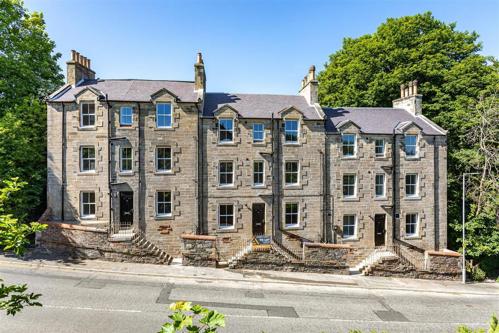
Vacant for nearly two decades, this landmark C-listed tenement in Galashiels, declined into a state of disrepair. Today, it represents renewal, preserving the architectural legacy of late mill workers’ housing while delivering nine high-quality homes in a town facing significant housing pressures. Five of these homes are designated for affordable rent, directly addressing local need and aligning with the council’s Local Housing Strategy.
These buildings of local importance are a rare survival of their original form. Situated on a narrow, steeply sloping site, the building presented significant technical challenges. Listed on the Buildings at Risk Register, it required comprehensive repairs, damaged by fire and water ingress. Fortunately, the buildings stonework remained in relatively good condition, however issues with the roof were becoming increasingly apparent, and the interior was in a severe state of disrepair. With all internal floors affected it was possible to see the damaged roof standing on the solum of the ground floor. The scale of deterioration made this a particularly complex and ambitious restoration.
Despite these challenges, the restoration has been carried out with exceptional care. The building’s historic character has been retained, while modern, energy-efficient features have been sensitively integrated. The result is a mix of one- and two- bedroom flats that can cater to a wide demographic, from young professionals to older residents, supporting community diversity.
The building holds emotional significance for many locals, as reflected in the press and shared on social media. These connections have helped foster a renewed sense of place and pride, contributing to the social fabric of the town.
Working in partnership with the local authority the owner shares a commitment to social impact by supporting applications from key housing pressure groups, including key workers, Ukrainian resettlement applicants, and individuals experiencing homelessness. This aligns with the council’s Rapid Rehousing Transition Plan and the broader national response to the housing emergency declared in May 2024.
By refurbishing rather than demolishing, the project has significantly reduced carbon emissions and construction waste. This approach supports the council’s climate goals and sustainable development objectives. The use of high-quality materials and thoughtful design, with smart storage solutions enhancing functionality, future proofs these homes for generations.
In the context of the current housing emergency, every home matters. These homes play a crucial role in alleviating housing pressures.
Homeowners like this are investing in our built heritage, protecting and future-proofing it, while creating much-needed homes and contributing to our communities and economy. By bridging renovation gaps, the grant scheme helps to address barriers to bringing empty homes back into use. The scheme not only enhances the housing stock but also supports broader strategic objectives related to community development, economic growth, and sustainability.
This project exemplifies the power of partnership. The collaboration between the private owner, local authority, and community stakeholders has delivered a result greater than the sum of its parts. It demonstrates how regeneration can be both respectful of the past and responsive to the future.
Outcomes and achievements
The restoration of Kirkbrae has delivered significant outcomes across physical, social, and economic factors. From a building that stood empty for nearly 20 years, nine high-quality homes have emerged, five of which are designated for affordable rent through the SBC Empty Homes Grant Scheme. This directly supports the council’s strategic housing priorities and contributes to community stability.
The project has preserved a historically significant structure, enriching the town’s architectural heritage and enhancing its visual character.
Social impact has been prioritised. Future tenants will include key workers, displaced individuals, and those at risk of homelessness, groups identified in the council’s housing emergency response. This inclusive approach ensures the homes contributes meaningfully to wider social regeneration.
Sustainability has been a key achievement. The reuse of the existing structure has reduced environmental impact, while the incorporation of durable, efficient materials ensures long-term viability. The project reflects the success of the SBC Empty Homes Grant Scheme, which has and is continuing to support owners across the Scottish Borders bring empty homes back into use.
West Dunbartonshire Council - Clydebank East
Application entry
- Project name: Clydebank East
- Lead organisation: West Dunbartonshire Council
- Partner organisation: CCG
Statement of support
Partnership working
Clydebank East is a new development of 88 high-quality affordable homes, delivered in partnership by West Dunbartonshire Council, CCG (Scotland), and Anderson Bell + Christie Architects. Located in a regeneration area, the project has transformed a previously neglected site into a vibrant, inclusive neighbourhood. The designs were shaped through layered community consultation, including public events and online engagement, ensuring local voices were heard throughout the process.
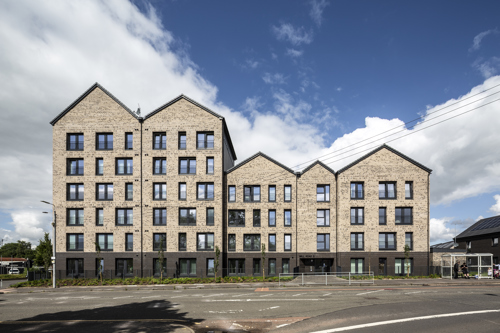
Revitalising communities and lasting improvements
The development has transformed a long-neglected site with a complex history, previously a greyhound track then high-rise flats, into a well-connected and inclusive neighbourhood. Its location between Clydebank and Glasgow, near Yoker Station and major bus routes, makes it a natural gateway into West Dunbartonshire. Improved walking and cycling routes, enhanced public transport access, and new green spaces have reconnected the area and encouraged active travel. The newly opened Renfrew Bridge, just across from the development, adds vital links to Renfrewshire and direct access to Glasgow Airport. Homes are designed for a diverse mix of residents, including families, older people, and those with mobility needs.
Urban strategy and sense of place
The site layout follows a clear design hierarchy that responds to its urban setting.
Homes and open spaces were planned together to create distinct areas that encourage neighbourliness and identity. A key feature is the cycle and pedestrian route running north to south through the site, reconnecting Clydebank’s residential areas with the waterfront and breaking down the site’s previously isolated feel. Green buffers soften edges near busy roads, while mounding along Glasgow Road provides a more human-scale boundary. Tree-lined streets, shared spaces, public art seating, and a play zone offer inviting places for residents and encourage community use. These elements create a neighbourhood that is easy to navigate, supports everyday life, and feels part of the wider community.
A strong frontage is formed at the corner of Glasgow Road and Mill Road, marked by a prominent flatted block that defines the entrance and addresses the road network and surrounding buildings. Further into the site, a central cluster introduces secondary frontage and helps separate public and private spaces, encouraging interaction while maintaining privacy. Towards the western and northern edges, housing becomes lower in scale, with bungalows near a landscaped mound offering quieter living. This gradual transition helps the development blend into its surroundings and gives each area a distinct character.
Design quality and housing mix
The housing mix was developed with WDC to meet a broad range of local needs. There are one to five-bedroom homes, including nine fully wheelchair-accessible properties. Most homes are terraced, providing privacy and efficient use of space, while an L-shaped flatted block offers dual-aspect apartments with views onto shared green spaces. The corner block at Glasgow Road and Mill Road acts as a gateway, with its bold form, saw-tooth roof, and tall gables giving it a strong presence.
Across the site, homes share a consistent design with pitched roofs, vertical windows, and subtle detailing like deep window reveals and patterned brickwork. Two brick tones-buff and dark grey-unify the development, with the flatted block combining both for contrast and smaller homes using a single tone for a domestic feel. Dark grey window frames and roof tiles complete the palette, giving the neighbourhood a modern and cohesive identity.
Sustainability
Clydebank East is West Dunbartonshire’s first “net zero ready” housing development. Each home meets Silver Active Level standards, with high-performance insulation, triple glazing, and zero-emissions heating-individual Air Source Heat Pumps for houses and a communal system for flats. Solar panels across the site help lower energy costs and reduce carbon emissions.
Outcomes and achievements
Clydebank East delivers affordable housing in a regeneration area - transforming an underused site into a thriving, inclusive neighbourhood of 88 high-quality homes. Delivered collaboratively by West Dunbartonshire Council, CCG (Scotland), and Anderson Bell + Christie Architects, the development reconnects Clydebank with Glasgow through improved transport links, enhanced walking and cycling routes, and the introduction of new green spaces.
The design was shaped through community consultation, ensuring local voices influenced the outcome. The housing mix-ranging from one to five-bedroom homes, including nine wheelchair-accessible properties - responds to a wide range of needs, supporting families, older residents, and wheelchair users. The layout and landscaping promote a strong sense of place, with tree-lined streets, shared spaces, public art, and a dedicated play zone encouraging neighbourly interaction and community identity.
Clydebank East is West Dunbartonshire’s first fully “net zero ready” housing development. Sustainability is embedded through high-performance insulation, triple glazing, individual and communal air source heat pump and solar panels, all contributing to reduced emissions and lower energy costs.
The project re-establishes a sense of community in an area with a complex past and supports the wider regeneration of Clydebank. It is a well-connected, resilient neighbourhood designed for the future.
Scottish Borders Housing Association - Butler Court, Jedburgh
Application entry
- Project name: Butler Court, Jedburgh
- Lead organisation: Scottish Borders Housing Association
- Partner organisation: HUSK Garage-to-Home Regeneration Specialists
Statement of support
Scottish Borders Housing Association (SBHA) has pioneered a new approach to community regeneration with Scotland’s first Garages to Homes (G2H) development, transforming underused, problematic garage sites into high-quality, accessible, and energy-efficient homes. Delivered in partnership with regeneration specialists HUSK, this innovative scheme sets a new standard for sustainable, space-efficient housing development in areas where traditional building methods have proved unviable.
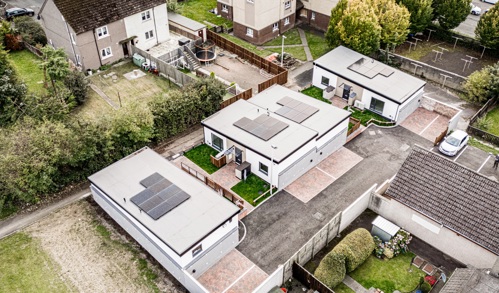
The flagship project at Butler Court, Jedburgh, has seen four accessible bungalows created from disused garage blocks. A further three homes have been delivered on Lothian Road in the town, with six more to follow shortly in Hawick — delivering a total of 10 two-bedroom and three one-bedroom homes across the programme.
The concept addresses the long-standing issues of redundant garage sites:
- Low value – underused garages often generate little income, with high maintenance demands
- Anti-social behaviour – neglected sites attract fly-tipping, vandalism, and crime
- Development barriers – proximity to neighbouring homes and awkward layouts often make them impossible to develop with standard housebuilding methods.
The HUSK system provides the solution. By retaining the shell of the exterior structure of the garage block and reconfiguring five to six garage units to create a single home, the model reuses existing structures to minimise waste, preserve privacy distances, and cut demolition costs. Homes are manufactured off-site in controlled factory conditions, ensuring consistent quality and rapid installation, reducing disruption to surrounding residents.
The resulting properties offer features rarely seen in developments of this scale:
- Fully level access throughout
- Adapted shower rooms for accessibility
- Air source heat pumps and photovoltaic (PV) solar panels
- Fire suppression systems
- A-rated Energy Performance Certificates (EPCs) for low running costs.
The project has been delivered with support from South of Scotland Enterprise (SOSE), whose funding enabled the feasibility study, alongside backing from the Scottish government, Scottish Borders Council, and Royal Bank of Scotland. Early engagement with local residents and stakeholders ensured the homes were designed to meet identified needs and blend sensitively with the surrounding neighbourhoods.
Beyond the buildings, the scheme invests in the fabric of the community. Previously underused and unattractive spaces have been replaced with vibrant new homes that contribute to the local streetscape, enhance safety, and encourage pride in place.
The development also carries a strong sense of local identity. Butler Court is named in honour of Bill Butler, a well-known Jedburgh figure whose garage business, community spirit, and involvement in local events made him a much-loved resident. The name reflects both the site’s history and the project’s commitment to local heritage.
- For tenants, the transformation is life-changing. Jeanette Elliot, who moved in with her son, said: “It’s absolutely brilliant. Being able to walk out my front door without steps, and having a wet room, has made life so much easier.”
- Future resident Alexandra Bera is equally positive: “It’s lovely and bright as my new home gets so much more sunshine. It’s uplifting!”
This first-of-its-kind development in Scotland has already drawn interest from affordable housing providers nationwide. It offers a replicable, cost-effective solution to increasing housing supply, meeting accessibility needs, and regenerating underused land sustainably.
Outcomes and achievements
The Butler Court Garages to Homes development has delivered Scotland’s first homes created using the HUSK system, proving the viability of transforming redundant garage sites into high-quality, accessible, sustainable housing.
Key achievements include:
- Creation of seven homes in Jedburgh (with six more in Hawick to follow), all meeting high energy efficiency standards (EPC A)
- Successful use of modern methods of construction to repurpose existing structures, cutting waste, construction time, and disruption
- Provision of fully accessible homes with level access, adapted bathrooms, and low running costs — directly addressing local housing needs
- Regeneration of sites previously linked to anti-social behaviour, improving neighbourhood safety and appearance
- Preservation of community character through meaningful engagement and locally inspired naming.
This innovative offers a scalable solution to the housing emergency while promoting sustainability, community pride, and quality of life, offering homes that people want to live in, in areas where they want to stay.
North Lanarkshire Council - YMCA - Brandon Street, Motherwell
Application entry
- Project name: YMCA - Brandon Street, Motherwell
- Lead organisation: North Lanarkshire Council
- Partner organisations: CCG (Scotland) Ltd, Coltart Earley Architecture, Scottish Government More Homes
Statement of support
North Lanarkshire Council is delivering on its ambitious vision to provide 6,000 new affordable homes by 2035. To date, 1,629 homes have been completed, with Brandon Street in Motherwell delivered as a flagship development.
Built on a long-derelict site in the town centre, Brandon Street reimagines the area with 48 high-quality homes for social rent. The B-listed YMCA landmark, originally built in 1898 but lain derelict since 2014, which has been brought back into use in a key town centre location. Six homes are located within the sympathetically refurbished former YMCA listed building, with 42 new-build flats delivered in two adjacent new build blocks. The homes offer a mix of one-, two-, and three-bedroom flats, specifically delivered for Over-55s with fully wheelchair-accessible ground floor units, ensuring inclusivity and independent living for all residents.
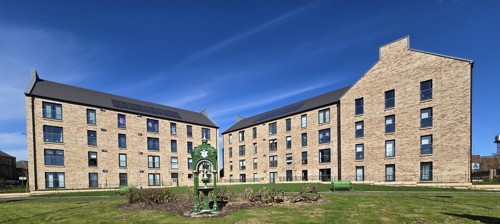
- The positive impact on residents is clear. One resident shared: “I am thoroughly enjoying my new home and love how friendly the neighbours are. I moved from an upstairs cottage flat to a ground level wheelchair-accessible flat which is perfect and helps with my mobility.”
This reflects the thoughtful design approach that prioritises both accessibility and quality of life.
Brandon Street’s sense of place contributes to the overall success of the regeneration project. Positioned in the heart of Motherwell, residents enjoy being in close proximity to supermarkets, healthcare facilities, restaurants, public transport, and other amenities. Secure cycle storage and access to two nearby railway stations encourage sustainable travel and support the concept of a 20-minute neighbourhood, reducing reliance on private cars and contributing to wider social and environmental goals.
Sustainability is deeply embedded in the development. Each home features a highly efficient ground source heat pump connected to a shared system of on-site subterranean boreholes. This low-carbon energy solution, supported by Scotland’s Heat Network Fund, cuts carbon emissions, enables independent fair tenant billing and helps combat fuel poverty.
The homes are equipped with Mechanical Heat Recovery Ventilation (MHRV) systems, which enhance both energy performance and indoor air quality. One tenant remarked: “I have not used my inhaler once since moving in—I’ve noticed a big difference in the air quality.”
These features ensure the homes are sustainable, future-proofed and aligned with Scotland’s net zero goals.
Brandon Street is more than a housing project, it is a catalyst for community, sustainability, and urban renewal. It demonstrates what can be achieved when local authorities, national government, architects, contractors, and communities work together with a shared vision in partnership. The successful delivery of the project has been realised through the committed and determined approach of all stakeholders involved in this multifaceted regeneration project.
Brandon Street has increased the local supply of affordable housing and supported the relocation of elderly tenants from nearby high-rise blocks planned for demolition as part of wider local regeneration strategy.
Architecturally, the project is a model of heritage-led regeneration. The careful restoration of the YMCA building and the reinstatement of the historic drinking fountain have helped restore a strong sense of place. The site includes thoughtfully landscaped amenity spaces, walkways, and seating, which are now well-used gathering places for residents.
The council set out to create a characterful, cohesive neighbourhood that reflects the heritage of Motherwell while meeting modern housing standards. That vision has been fully realised. Brandon Street enhances the streetscape, revitalises a forgotten site, and creates a safe, welcoming environment—particularly for over-55s.
With its blend of heritage, sustainability, inclusivity, and transformative community impact, Brandon Street sets a new benchmark for affordable housing in Scotland. It preserves the past, serves the present, and builds for the future, especially from the perspective of regeneration and sustainability.
Outcomes and achievements
Brandon Street showcases how affordable housing can transform lives, regenerate town centres, and promote sustainability. It sets a new benchmark for town centre living for affordable housing in Scotland, combining design excellence, environmental responsibility, and social impact.
Project outcome:
- Delivered 48 high-quality, affordable homes for over-55s as part of wider regeneration of Motherwell
- Preserved architectural heritage and supported urban regeneration at a key town centre location.
Achievements:
- Transformed the derelict 1898 YMCA building into six refurbished flats
- Two new-build blocks added 42 flats, totalling 48 energy-efficient homes for social rent
- Preserved existing local business unit within the YMCA conversion
- Ground source heat pumps installed, reducing emissions and improving energy efficiency
- Blended modern housing with heritage preservation
- Retained original features: YMCA façade, boundary walls, and ground floor flooring
- Increased affordable housing in a high-demand letting area
- Rehoused older residents from high-rise blocks scheduled for demolition
- Varied flat sizes (one to three bedrooms) catering to diverse needs
- Created local jobs: four new staff and two apprentices hired by CCG
- Community Benefits - school visits and career events
- Model of sustainable development and heritage-led regeneration.
Brandon Street embodies the transformative potential of affordable housing: preserving heritage, enhancing lives, and shaping the future of Motherwell.



